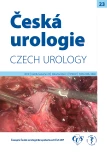Laparoscopic radical cystectomy with open ureteroileostomy
Authors:
Milan Hora; Petr Stránský; Tomáš Pitra; Tomáš Ürge; Ivan Trávníček
Authors‘ workplace:
Urologická klinika LF UK a FN Plzeň
Published in:
Ces Urol 2019; 23(1): 13-15
Category:
Video
Overview
Aim of study: The aim of this work is to present our approach to laparoscopic radical cystectomy (LRC), which we introduced in ERAS implementation. ERAS (Enhanced Recovery After Surgery) in Radical Cystectomy (RC) includes 22 measures, one of which is the use of mini‑invasive approaches. For these reasons, we have implemented laparoscopy for RC, although not all ERAS measures have been introduced. Pure laparoscopy versus robotic has limited possibilities for intracorporal diversion, so we combine laparoscopic ablation phase with extracorporal diversion. Only in RC with concomitant unilateral nephrourectomy (mostly for non‑functioning kidney in advanced megaureter) and ureterocutaneostomy is performed completely laparoscopically. RC with orthotopic neobladder, we are still perform entirdy openly.
Material and methods: In the period 1 / 2010- 12 / 2018, 246 RCs were performed. Of which 229 for urothelial carcinoma. Since 2014, laparoscopy (LRC) has been implemented in 38 (in 8 women). From 2015 LRC formed 29.1% (37/127) of all cystectomies. For LRC, patients with BMI up to 30, less advanced (not T4, N2-3), without other complications (e.g. previous extensive intra‑abdominal surgery), performed by a specialized surgical team in oncology and laparoscopy.
Results: The operation time of 38 LRC was 239 ± 36 (198–418) min. Blood loss 588 ± 643 (120– 4000) ml. Average BMI 28. 5. In 26, LRC was combined with extracorporal ureteroileostomy from short laparotomy. For the remaining 12, the LRC was associated with a one‑sided nephrourerectomy (which was always preceded in flank position before own RC), followed by a laparoscopic ureterocutanostomy. Conversion was not necessary. Severe complications occurred in 3, i.e. 7.9 % (2× Clavien IIIb - wound re‑suture, reintroduction of stents and 1× V - pulmonary embolism death). In the entire 246 RC set, IIIb‑V was 58 (23.6%). Long‑term oncological results have not yet been evaluated.
Video: Laparoscopic radical cystectomy with extracorporal ureteroileostomy: Trendelenburg position, 5 ports (10, 12 and 3× 5 mm), 3D imaging, surgeon and 2 assistants. The Ligasure Blunt tip 5 mm® sealing tool is used for both pelvic lymphadenectomy and its own RC. Only in male is sometimes used on the Santorini plexus V‑Loc ® 90 stitch. The peritoneum is opened, the ureters released and transacted above the urinary bladder, followed by lymphadenectomy along the external iliac vessels and the obturator bundle. Division of the pedicles of the urinary bladder. In females as part of anterior exenteration resected the front wall of the vagina is resected below under the bladder. From the subsequent paraumbilical minilaparotomy (about 7 cm) the specimen is extracted and an appendectomy and ureteroileostomy are performed.
Conclusion: Laparoscopic RC with extracorporal ureteroileostomy is feasible and has become a standard for reducing the incidence of postoperative complications in selected (about one third) patients (BMI to 33, less advanced tumours). It does not require any special equipment (ports, sealing tool, staplers and extensive use of clips are not necessary). An condition is an experienced laparoscopic team is necessary.
Keywords:
laparoscopy – Tumor of urinary bladder – Cystectomy
Sources
1. Cerantola Y, Valerio M, Persson B, et al. Guidelines for perioperative care after radical cystectomy for bladder cancer: Enhanced Recovery After Surgery (ERAS(R)) society recommendations. Clinical nutrition (Edinburgh, Scotland) 2013; 32(6): 879–887.
2. Balík M, Hušek P, Holub L, Košina J, Broďák M. Laparoskopická cystektomie – první zkušenosti. Ces Urol 2015; 19(3): 194–200.
3. Balík M, Košina J, Špaček J, et al. Laparoskopická radikální cystektomie u muže – video 2015. Ces Urol 2016; 20(2): 100–103.
4. Hora M, Stránský P, Ürge T, et al. Laparoskopická extraperitoneální radikální prostatektomie nervy šetřící – video. Ces Urol 2017; 21(4): 268–271.
Labels
Paediatric urologist Nephrology UrologyArticle was published in
Czech Urology

2019 Issue 1
Most read in this issue
- Endometriosis of the bladder as a cause of iatrogenic bladder perforation
- Use of PSA density and multiparametric MRI for indication of prostate biopsy
- A urologists view of hematuria in pediatric patients
- Diagnosis, therapy and urological complications of cloacal malformations
